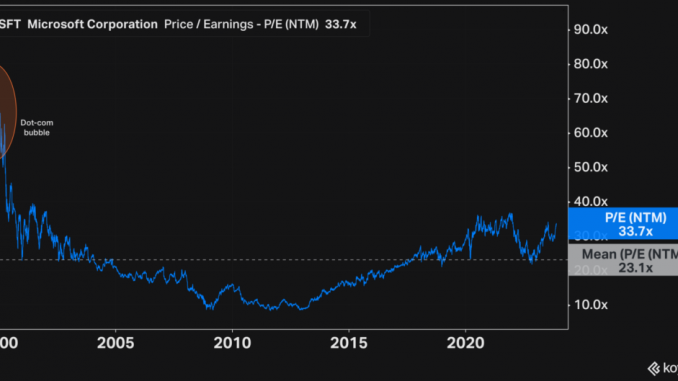
Microsoft Corp. (NASDAQ:MSFT) reached unprecedented heights in its stock performance, touching a new all-time high of $377 per share in the Nov. 22 session.
This impressive performance adds to the tech giant’s stellar year, with a year-to-date gain of 57%, reminiscent of its glory days in 2009 and even reaching levels not seen since 1999.
Market capitalization now stands at a staggering $2.8 trillion, closely trailing Apple Inc.’s (NASDAQ:AAPL) dominance by a mere $140 billion.
Driving Forces Behind Microsoft’s Remarkable Surge

Several key factors have driven Microsoft’s incredible ascent.
One pivotal development was Microsoft’s emergence as a leader in the world of AI, particularly with its acquisition of OpenAI. This strategic move solidified its position as a key player in the Generative AI era.
Additionally, Microsoft’s dominance in the cloud computing sector, notably through its Azure platform and Office suite, has been a significant contributor to its success. Cloud services continued to be a lucrative growth engine, bolstering the company’s financial performance.
In the third quarter of 2023, Microsoft reported record-breaking revenue of $56.5 billion, slightly surpassing Street’s estimates and marking a substantial 13% increase compared to last year’s same period. Notably, the tech titan also surpassed earnings per share (EPS) expectations, posting $2.99, compared to the anticipated $2.65. This performance also marked an improvement over the previous quarter’s EPS of $2.69.
Goldman Sachs analysts identified Microsoft as one of the most compelling investment opportunities in the tech industry and across sectors.
Wall Street anticipated a further 10% rise in Microsoft’s shares, setting a 1-year median price target at $406.
Microsoft’s P/E Ratio: Cautionary Signs Emerge
Despite the overwhelmingly positive sentiment surrounding Microsoft, certain fundamental and technical indicators raised cautious flags among investors.
While not indicative of extreme concerns, they warrant attention.
Investors might have already priced in a significant portion of the company’s future growth, as Microsoft’s stock prices surged at a faster rate than anticipated earnings.
Microsoft’s forward price-to-earnings (P/E) ratio, which assessed the current stock price relative to projected earnings over the next 12 months, has risen to 33x.
Although this figure is not far from previous highs of 34x reached in July and the multi-decade highs of 37x seen at the end of 2021, it was worth noting a higher forward P/E ratio often implied a relatively expensive valuation.
Over the past two decades, Microsoft’s forward P/E ratio typically averaged around 20x-23x. While the current valuation was undoubtedly on the expensive side, it had not yet reached bubble territory. During the dot-com bubble of the late 1990s, Microsoft’s price-to-earnings ratio exceeded a staggering 80x.
Technical Indicators Screen Bearish RSI Divergence
Technical indicators, such as the Relative Strength Index (RSI), were also sending cautionary signals.

The RSI oscillated in and out of the overbought zone, crossing the 70 mark at times, which could indicate a potential overextension in the stock’s price.
The question on investors’ minds now was whether it was time to lock in some profits, before a potential pullback. Over the past year, Microsoft experienced temporary pullbacks accompanied by what is known as a “bearish RSI divergence.
This divergence occurred when the stock’s price set new highs while the RSI declined from prior highs.
Typically, this signals a weakening of bullish momentum and can trigger profit-taking behavior among investors. As of today’s closing, Microsoft might be showing signs of another bearish RSI divergence.
Produced in association with Benzinga
